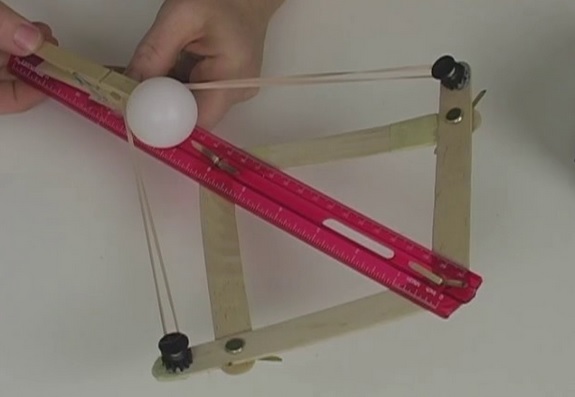Everything in the universe takes one of two forms: energy and matter. This experiment explores the idea that energy can never be created or destroyed, but it can transform. All the different forms of energy (heat, electrical, nuclear, sound etc.) can be broken down into two categories, potential and kinetic energy.
Think of potential energy the “could” energy. The battery “could” power the flashlight. The light “could” turn on. I “could” make a sound. That ball “could” fall off the wall. That candy bar “could” give me energy. Potential energy is the energy that something has that can be released. For example, the battery has the potential energy to light the bulb of the flashlight if the flashlight is turned on and the energy is released from the battery. Your legs have the potential energy to make you hop up and down if you want to release that energy (like you do whenever it’s time to do science!). The fuel in a gas tank has the potential energy to make the car move.
Kinetic energy is the energy of motion. Kinetic energy is an expression of the fact that a moving object can do work on anything it hits; it describes the amount of work the object could do as a result of its motion. Whether something is zooming, racing, spinning, rotating, speeding, flying, or diving… if it’s moving, it has kinetic energy. How much energy it has depends on two important things: how fast it’s going and how much it weighs.
We’re utilizing the elasticity of the rubber band to store potential energy to fling the ball around the room. The potential energy in the rubber band is transformed into kinetic energy of the moving ball when you hit the trigger to release the rubber band.
[am4show have='p8;p9;p100;' guest_error='Guest error message' user_error='User error message' ]
Materials:
- two rubber bands
- one marshmallow
- one plastic ruler with a groove down the middle
- four brass fasteners
- five popsicle sticks
- wood clothespin
- two pegs (see video)
But what happens after you toss the ball?
When you simply drop a ball, it falls 16 feet the first second you release it. If you throw the ball using your marshmallow launcher, it will also fall 16 feet in the first second. The ball (or marshmallow) moves both away from you and down toward the ground once it’s released.
What if you throw it faster, and faster? Think about a bullet shot horizontally. It travels a lot faster than you can throw (about 2,000 feet each second). But it will still fall 16 feet during that first second, no matter how fast you fire it.
It’s because gravity pulls on all objects (like the ball and the bullet) the same way, no matter how fast they go. Catapults and marshmallow launchers like the one we just made are a nifty way to fire things both vertically and horizontally so you can get a better feel for how objects fly through the air. Notice when you launch how the balls always fall at the same rate.
After you have your launcher working, it’s time to measure some data and look at the physics behind this projectile motion. Let’s calculate the horizontal speed that your ball is traveling at, if you measured that it traveled 54 inches (4.5 ft), in 1.25 seconds.
To calculate the horizontal speed, we will use the following equation, where v is the horizontal speed, d is the horizontal distance, and t is time:
v = d / t
so if the ball traveled 20 feet in 4 seconds:
v = (20 ft) / 4 sec or
v = 5 ft/s
[/am4show]


Thanks A lot Aurora 🙂
I think I used the 1″ brass fasteners, the 2″ are too big for the popsicle sticks. You can use other things as well, like tacks and hot glue (for the pointy ends).
What’s the size of your brass fasteners?